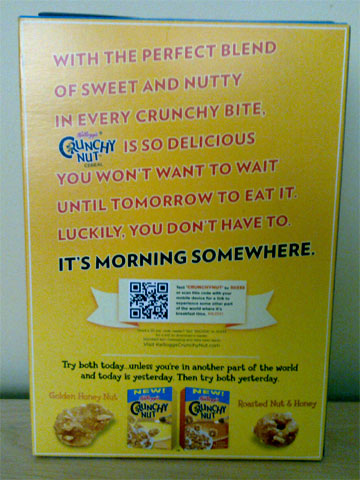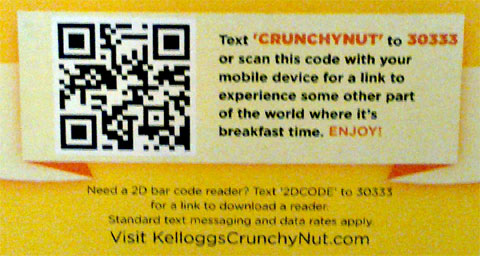A visit to the cereal aisle of a US supermarket is always an overwhelming experience, as with each visit it appears that there’s even more choices to make. In this crowded field of breakfast foods, you need to stand out somehow, and why not with a QR code?
A new variety of cereal, Crunchy Nut from Kellogg’s, featured a QR code on the back of its cereal box as shown below:

Note there was not a QR code on the front of the box, and I discovered this when I went to buy the cereal. The detail of the QR code is shown below:

Upon scanning the code, you are taken to a mobile Web optimized site where it shows a video reinforcing its marketing message about eating the cereal day or night because “it’s morning somewhere.” I have visited the site a few times and I observed different videos.
This a good example of a presentation of a QR code as well as what it links to. In a prominent location, the message offers both the option to send an SMS message or to scan the code, and below it tells the cereal eater how they can get a reader app, and if they do so, they may be charged for it. In this case, Kellogg’s chose to call it a 2D bar code, and my guess all of this text was vetted by their legal department and thus it is called as such, as technically QR code is a trademarked name, but offered as an open standard.
Only if the cereal lived up to the quality of the QR code presentation – it was a little bland for my taste, and not that crunchy either, but I digress. The QR code won me over in this case.
Did you enjoy reading this? You are welcome to subscribe to The Hot Iron by RSS feed or by email.
Build •
Mobile Technology •
QR Codes •
QR Codes In Action •
Technology •
(6)
Comments •
Permalink
Comments
Mike,
How do you see QR codes being used for in the future? I’ve been seeing more of them around and I’m starting to wonder if their necessary or not. I think there’s a cool factor associated with them, but in a lot of instances I think it would be just as simple to print the link to the site or a short code to text.
I’m not against them, I’m just wondering if there is a better way to use them. I’m a graphic designer working at a publishing company. We are starting to put them on our products and for the most part I think it’s pointless (not to mention that they aren’t pretty and you have to make them at least an inch to be useful). It makes sense as a tool to enhance what the reader is reading, especially if it’s a long url. It feels like we’re using them because a marketing person read somewhere that QR codes are the future so we must use them. I think that their function should be more important than their cool factor.
I would love to see them used to help consumers remember products, similar to how Best Buy is using them. It would be nice if they were integrated into something like Evernote or Springpad so that I could keep track of products I’m interested in. I envision reading a magazine and seeing them printed small in the corner, or on a billboard or a commercial.
Sorry for the rant, but it’s been front of mind lately and I wanted to get the opinion of someone who is interested in QR codes and the tech behind them. So I’ll end where I started, how do you see QR codes being used in the future?

Comment by M. Lane
on 03/02/11 at 10:21 AM
@M - Thanks for your message. As much as I am a fan of QR codes and am offering them as a service to my clients at Dunkirk, they are a tool, and like any tool, it doesn’t work in all situations.
QR codes, in my mind, are a bridge to more information. Not only can a QR code have an embedded URL, but contact information and a simple text message as well, and I see very few applications of those. They should also fit the audience - I wouldn’t be putting QR codes on the newsletter for a senior center, but it would suit one for a youth group.
Whatever their use, what they offer or link to should add some value. Just providing a link back to the home page of a Web site isn’t necessarily value, but if it links to a product or another landing page, then there could be value. It also makes sense to test them - both using them and not using them, as well as how they appear on the page and where.
In the posts I am writing on QR codes, my goal is not only to say, “look, here’s another QR code” but discuss how it is being used, and opinion on its potential effectiveness.
QR codes have been around for a while, and only have been becoming more popular in the US. As for where I see them going, I see more experimentation with them, and if there’s a camera on the new iPad, watch for further integration into apps.
mp/m

Comment by
Mike Maddaloni
on 03/02/11 at 11:11 AM
We have a difference of opinion here… http://www.2dbarcodestrategy.com/2011/02/kelloggs-crunchy-nut-uses-qr-code.html
I have to agree with Roger’s conclusion - it’s actually a poor use of the opportunity considering the size of the company. There’s a follow up post on Roger’s site with some unhelpful words from the agency responsible.

Comment by
Steve O'Connor
on 03/02/11 at 01:03 PM
@Steve - Thanks for the link and your insights. I do agree they could have done more with the resulting site. However it is good to see a large company take some “risks” with something like using QR codes. What would be great to hear is how effective the campaign was.
mp/m

Comment by
Mike Maddaloni
on 03/02/11 at 01:27 PM
That’s kind of an odd use for a QR code. I suppose if you let a 6 year old scan it and watch the video you might get a “do it again” out of him/her. Other than that, I don’t see the point.
The 2 biggest fails I see with QR code usage is moving sideways and not meeting user expectations. (Both of which can be bundled into one failed exercise.)
By moving sideways I mean not moving people to take further action. People who know what a QR code is scan it for 3 main reasons 1) access to promotions or coupons 2) relevant additional info. 3) curiosity.
Example: I scanned a wristwatch ad in a national newspaper expecting to learn more about that watch or why I should by from that watch maker. Those were my expectations.
I was taken to a mobile-friendly catalog of watches and the option to find a nearby retailer. There was no additional decision-making information such as about the craftsmanship, price info, company reputation, etc. Dead end. A sideways exercise like the Kelloggs video.
Yet I have no doubt that the agency who put it all together thought it was a great way to use a cool new thing (the QR code) to get their client some brand exposure.
Anyway, QR codes have really started to take off and in our analytics-driven world it won’t be long before marketers are in sync with user expectations.

Comment by
Dave Goodwin
on 06/23/11 at 04:46 PM
@Dave - Thanks for reading and commenting!
A lot of uses of QR codes I have seen fall under the “technology for technology’s sake” category. In some cases this is not harming to a brand or company, but if it really adds no value, then it may be all for not. A large company like Kellogg’s can afford to throw money at something simply to see how it works.
But as I said in the post, a QR code won’t make this cereal taste any better!
mp/m

Comment by
Mike Maddaloni
on 06/24/11 at 12:54 PM
Post a Comment
Note: Comment moderation is active, and your comment will be viewable once it is reviewed.



